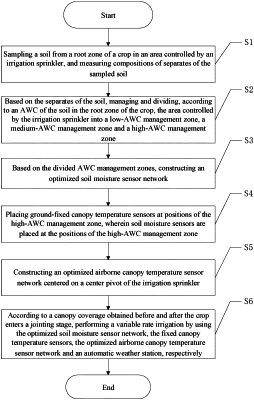| CPC A01G 25/167 (2013.01) [A01G 25/162 (2013.01); A01G 25/165 (2013.01); G01K 1/026 (2013.01); G01N 33/246 (2013.01); G01N 2033/245 (2013.01)] | 9 Claims |

|
1. A decision-making method for a variable rate irrigation management, comprising the following steps:
S1: sampling a soil from a root zone of a crop in an area controlled by an irrigation sprinkler, and measuring compositions of separates of the soil;
S2: based on the separates of the soil, managing and dividing, according to an available water capacity (AWC) of the soil in the root zone of the crop, the area controlled by the irrigation sprinkler into a low-AWC management zone, a medium-AWC management zone and a high-AWC management zone;
S3: based on the low-AWC management zone, the medium-AWC management zone and the high-AWC management zone, constructing an optimized soil moisture sensor network;
S4: placing ground-fixed canopy temperature sensors at positions of the high-AWC management zone, wherein soil moisture sensors are placed at the positions of the high-AWC management zone;
S5: constructing an optimized airborne canopy temperature sensor network centered on a center pivot of the irrigation sprinkler; and
S6: according to a canopy coverage obtained before and after the crop enters a jointing stage, performing a variable rate irrigation by using the optimized soil moisture sensor network, the ground-fixed canopy temperature sensors, the optimized airborne canopy temperature sensor network and an automatic weather station, respectively,
wherein
in step S2, the managing and dividing of the area controlled by the irrigation sprinkler comprises:
based on the separates of the soil, calculating the AWC of the soil in the root zone of the crop by using a Rosetta software, and performing a management and division on the AWC of the soil in the root zone of the crop by using a Jenks natural breaks classification method to obtain the low-AWC management zone, the medium-AWC management zone, and the high-AWC management zone.
|